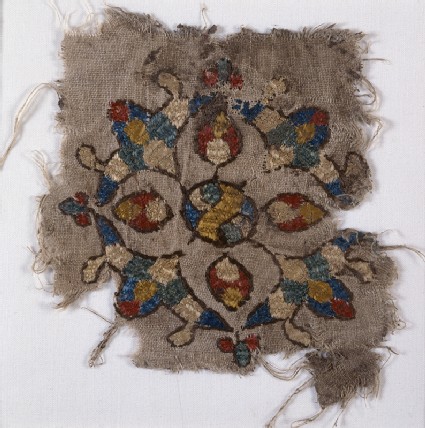Browse: 184 objects
- Reference URL
Actions
Textile fragment with cruciform palmette
-
Details
- Associated place
-
Near East (place of creation)
- Date
- late 15th century
- Material and technique
- linen, embroidered with coloured silk
- Dimensions
-
ground fabric 10.5 x 10.5 cm (height x width)
ground fabric 21 / 23 threads/cm (thread count)
ground fabric 0.04 cm (thread diameter)
additional fibre, embroidery 0.06 cm (thread diameter)
- Material index
-
organic › animal › animal product › silk
- Technique index
-
woven › plain woven,assembled › woven › plain woven,
- Object type index
- No. of items
- 1
- Credit line
- Presented by Professor Percy Newberry, 1941.
- Accession no.
- EA1993.101
-
Further reading
Ellis, Marianne, Embroideries and Samplers from Islamic Egypt (Oxford: Ashmolean Museum, in association with Greenville: Curious Works Press, 2001), no. 49 on p. 70, illus. p. 71
Barnes, Ruth and Marianne Ellis, ‘The Newberry Collection of Islamic Embroideries’, 4 vols, 2001, Oxford, Ashmolean Museum, cat. p. 62 (vol. iv), illus. vol. iv p. 62
Location
-
- currently in research collection
Objects are sometimes moved to a different location. Our object location data is usually updated on a monthly basis. Contact the Jameel Study Centre if you are planning to visit the museum to see a particular object on display, or would like to arrange an appointment to see an object in our reserve collections.
Publications online
-

Embroideries and Samplers from Islamic Egypt
The design of this embroidery suggests that it comes from the late 15th century Turcoman empire rather than Mamluk Egypt and Syria; at this period two Turcoman confederations controlled Eastern Anatolia, Northern Iraq and Western Iran. Its cruciform palmette and stylised lotus flowers show a Chinese influence characteristic of the 15th century. Its bright appearance is very different from other contemporary embroideries in the Newberry collection which generally have a very limited number of colours: here no less than six have been selected and arranged in small amounts, to give a jeweI-Iike appearance to the composition. Such use of colour is also found on 15th century Turcoman manuscripts.
The method of couching is similar to that seen on earlier 13th century embroidery from Egypt (Nos.45-48 [EA1984.76, EA1984.63, EA1993.99, EA1984.105]), but here the overcasting stitches are set very closely together to form defined ridged lines. The technique secured the underlying surface satin stitches so firmly that all the silk threads have remained intact. Looking at an embroidery from Safavid Iran in the collection of the Victoria and Albert Museum, London, (No.1206-1905), it is interesting to see that the same method of couching forming ridged parallel lines was still in use some two hundred years later. -

The Newberry Collection of Islamic Embroideries
A cusped quatrefoil contains a central roundel and four buds on its petals. It has four trefoils around its edge.
© 2013 University of Oxford - Ashmolean Museum

